Test Workflows - Services
This Workflows functionality is not available when running the Testkube Agent in Standalone Mode - Read More
Often if your use-case is more complex, you may need additional services for the Tests you are running. Common use cases are:
- Database, i.e. MongoDB or PostgreSQL
- Workers, i.e. remote JMeter workers or Selenium Grid's remote browsers
- Service under test, i.e. your API to run E2E tests against it
Testkube allows you to run such services for the Test Workflow, communicate with them and debug smoothly.
If you are using TestContainers to manage dependencies for your tests, check out this example for how to use TestContainers from your TestWorkflows.
How it works
When you define the service, the Test Workflow is creating a new pod and any other require resources for each of instances, read its status and logs, and provides its information (like IP) for use in further steps. After the service is no longer needed, it's cleaned up.
As the services are started in a separate pod, they don't share the file system with the Test Workflow execution. There are multiple ways to share data with them - either using one of techniques described below, or advanced Kubernetes' native ways like ReadWriteMany volumes.
Syntax
To add some services, you need to specify the services clause.
It can be either directly on the spec level (to be available for the whole execution), or on specific step
(to isolate it) - see Schema Reference.
You may want to use services in Test Workflow Template, to reuse them for multiple tests.
- YAML
- Log Output
apiVersion: testworkflows.testkube.io/v1
kind: TestWorkflow
metadata:
name: example-workflow-with-mongo-service
spec:
services:
db:
timeout: 5m
image: mongo:latest
env:
- name: MONGO_INITDB_ROOT_USERNAME
value: root
- name: MONGO_INITDB_ROOT_PASSWORD
value: p4ssw0rd
readinessProbe:
tcpSocket:
port: 27017
periodSeconds: 1
steps:
- name: Check if it is running
run:
image: mongo:latest
shell: |
echo Connecting to MongoDB at {{ services.db.0.ip }}
mongosh -u root -p p4ssw0rd {{ services.db.0.ip }} --eval 'db.serverStatus().localTime'
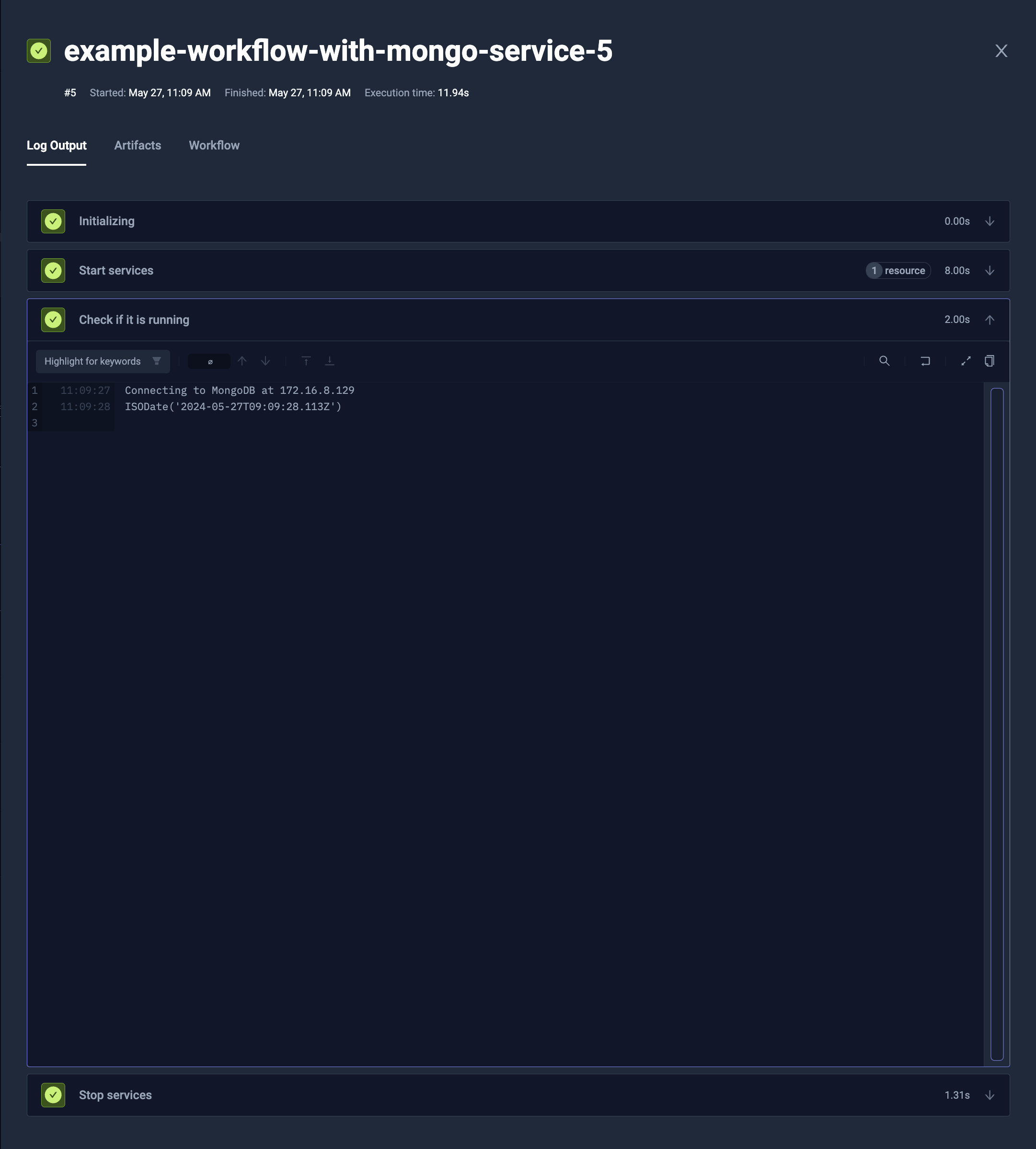
Connecting to the services
To connect to create services, you can simply use services.<SVC_NAME>.<INDEX>.ip expression in the place you need its address (i.e. environment variable, or shell command).
services.db.0.ipwill returnstring- IP of the 1st instance of thedbserviceservices.db.*.ipwill return[]string- list of IPs of all thedbservice instances
Basic configuration
The service allows similar fields as the run command, i.e.:
image,env,volumeMounts,resources- to configure the containercommand,args- to specify command to runshell- to specify script to run (instead ofcommand/args)descriptionthat may provide human-readable information for each instance separately
Fetching logs
By default we are not saving the logs for the services. If you would like to fetch the logs, you can use logs property.
It takes an expression condition, so you can dynamically choose whether it should be saved or not. Often you will use:
logs: alwaysto always store the logslogs: failedto store the logs only if the Test Workflow has failed
Pod configuration
The service is started as a separate pod, so you can configure pod similarly to the Test Workflow's configuration.
kind: TestWorkflow
apiVersion: testworkflows.testkube.io/v1
metadata:
name: example-workflow-with-mongo-service
spec:
services:
db:
pod:
tolerations:
- key: pool
operator: Equal
value: system
effect: NoSchedule
timeout: 6m
image: mongo:latest
env:
- name: MONGO_INITDB_ROOT_USERNAME
value: root
- name: MONGO_INITDB_ROOT_PASSWORD
value: p4ssw0rd
readinessProbe:
tcpSocket:
port: 27017
periodSeconds: 1
steps:
- name: Check if it is running
run:
image: mongo:latest
shell: |
echo Connecting to MongoDB at {{services.db.0.ip}}
mongosh -u root -p p4ssw0rd {{services.db.0.ip}} --eval 'db.serverStatus().localTime'
Lifecycle
You can apply readinessProbe to ensure that the service will be available for the next step.
The Test Workflow won't continue until the container will be ready then. To ensure that the execution won't get stuck, you can add timeout property (like timeout: 1h30m20s),
so it will fail if the service is not ready after that time.
The timeout duration encompasses all stages from the creation of the Kubernetes pod to executing the test request against the service. This includes scheduling the pod on a node, pulling the required image, waiting for the pod to become ready, and ultimately sending the test request. When starting your service for the first time, consider the time needed to pull the Docker image, which depends on its size. Additionally, if the necessary Kubernetes resources are unavailable and a new node needs to be spun up, this will further increase the startup time. Be sure to account for these factors when setting the timeout value.
Matrix and sharding
The services are meant to support matrix and sharding, to run multiple replicas and/or distribute the load across multiple instances.
It is supported by regular matrix/sharding properties (matrix, shards, count and maxCount).
You can read more about it in the general Matrix and Sharding documentation.
Step-level Services and dependencies
Services can also be defined on the step level, making them available only within the corresponding step, which enables
- Service isolation across steps
- Service dependencies, for example, if your step-level service(s) need to connect to a Workflow-level service.
The following example shows a Workflow that starts a Selenium Hub service at the Workflow level and
then starts two Selenium Chrome-Nodes as step-level services, connecting to the Selenium Hub service using {{ services.hub.0.ip }}
as the hub's IP address, and using nested steps to execute the actual test using these nodes.
kind: TestWorkflow
apiVersion: testworkflows.testkube.io/v1
metadata:
name: selenium-java-hub-and-nodes
description: "Selenium Java + Hub + Chrome Nodes"
spec:
config:
chromeNodes: {type: integer, default: 2}
junitParallelism: {type: integer, default: 4}
content:
git:
uri: https://github.com/kubeshop/testkube
revision: main
paths:
- test/selenium/selenium-java
container:
image: maven:3.9.11-eclipse-temurin-17
workingDir: /data/repo/test/selenium/selenium-java
resources:
requests:
cpu: 1
memory: 512Mi
services:
hub:
image: selenium/hub:4.34.0-20250727
timeout: 120s
logs: always
resources:
requests:
cpu: 300m
memory: 256Mi
readinessProbe:
httpGet:
path: /status
port: 4444
periodSeconds: 1
steps:
- name: Start node-chrome
services:
node-chrome:
image: selenium/node-chrome:112.0-chromedriver-112.0-grid-4.34.0-20250727
timeout: 120s
logs: always
count: config.chromeNodes
resources:
requests:
cpu: 500m
memory: 512Mi
readinessProbe:
httpGet:
path: /status
port: 5555
periodSeconds: 1
env:
- name: SE_EVENT_BUS_HOST
value: '{{ services.hub.0.ip }}'
- name: SE_EVENT_BUS_PUBLISH_PORT
value: "4442"
- name: SE_EVENT_BUS_SUBSCRIBE_PORT
value: "4443"
steps:
- name: Run test
run:
env:
- name: REMOTE_WEBDRIVER_URL
value: 'http://{{ services.hub.0.ip }}:4444/wd/hub'
- name: BROWSER
value: 'chrome'
- name: JUNIT_JUPITER_EXECUTION_PARALLEL_ENABLED
value: "true"
- name: JUNIT_JUPITER_EXECUTION_PARALLEL_MODE_DEFAULT
value: concurrent
- name: JUNIT_JUPITER_EXECUTION_PARALLEL_MODE_CLASSES_DEFAULT
value: concurrent
- name: JUNIT_JUPITER_EXECUTION_PARALLEL_CONFIG_STRATEGY
value: fixed
- name: JUNIT_JUPITER_EXECUTION_PARALLEL_CONFIG_FIXED_PARALLELISM
value: "{{ config.junitParallelism }}"
shell: |
mvn test
mvn surefire-report:report
artifacts:
paths:
- target/site/**/*
- target/surefire-reports/**/*
The output of this execution looks as follows:
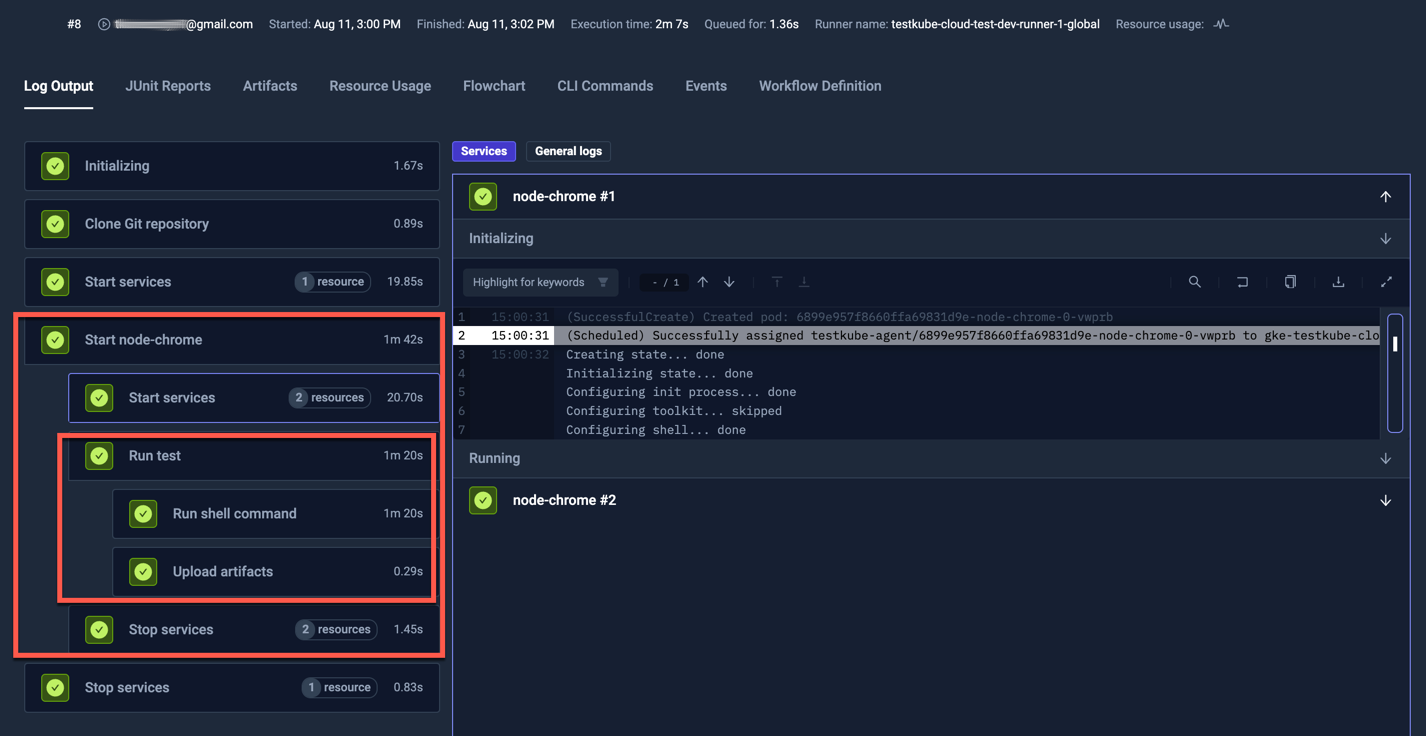
Providing content
There are multiple ways to provide the files inside the services.
As the services are started in a separate pod, they don't share the file system with the Test Workflow execution.
Copying content inside
It is possible to copy the files from the original Test Workflow into the services. As an example, you may want to fetch the repository and install the dependencies on the original TestWorkflow, and then distribute it to the services.
To do so, you can use transfer property. It takes list of files to transfer:
{ from: "/data/repo/build" }will copy the/data/repo/builddirectory from execution's Pod into/data/repo/buildin the service's Pod{ from: "/data/repo/build", to: "/out" }will copy the/data/repo/builddirectory from execution's Pod into/outin the service's Pod{ from: "/data/repo/build", to: "/out", "files": ["**/*.json"] }will copy only JSON files from the/data/repo/builddirectory from execution's Pod into/outin the service's Pod
Example
- YAML
- Log Output
apiVersion: testworkflows.testkube.io/v1
kind: TestWorkflow
metadata:
name: example-workflow-with-building-app-and-files-transfer
spec:
content:
git:
uri: https://github.com/kubeshop/testkube-docs.git
revision: main
container:
workingDir: /data/repo
resources:
requests:
cpu: 1
memory: 2Gi
steps:
- name: Build the application
run:
image: node:21
shell: npm i && npm run build
- name: Test the application
services:
server:
timeout: 1m
transfer:
- from: /data/repo/build
to: /usr/share/nginx/html
image: nginx:1.25.4
logs: always
readinessProbe:
httpGet:
path: /
port: 80
periodSeconds: 1
steps:
- shell: wget -q -O - {{ services.server.0.ip }}
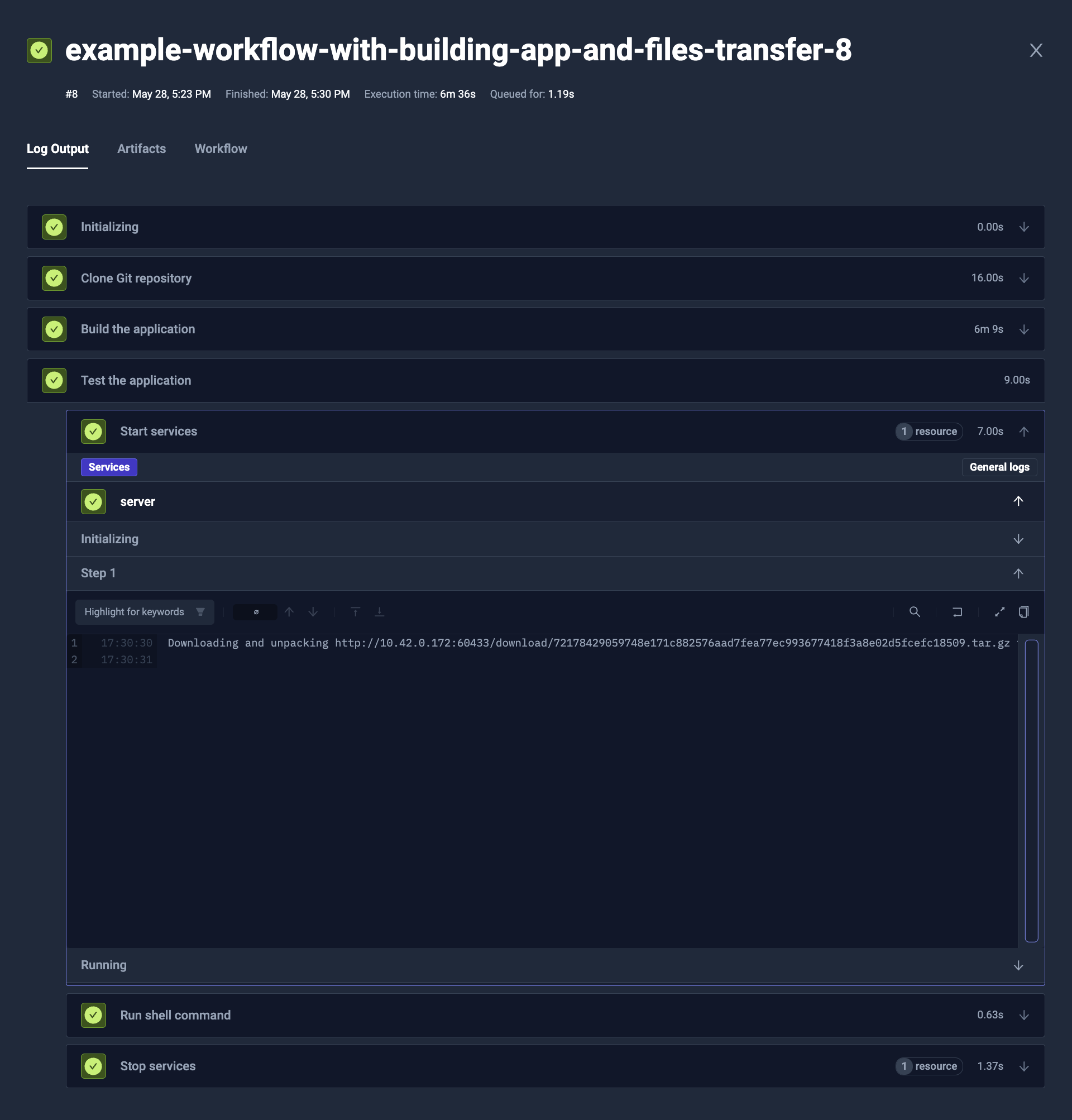
Static content or a Git repository
Services allow to provide the content property similar to the one directly in the Test Workflow. As an example, you may provide static configuration files to the service:
- YAML
- Log Output
apiVersion: testworkflows.testkube.io/v1
kind: TestWorkflow
metadata:
name: example-workflow-with-nginx
spec:
services:
http:
timeout: 5m
content:
files:
- path: /etc/nginx/nginx.conf
content: |
events { worker_connections 1024; }
http {
server {
listen 8888;
location / { root /www; }
}
}
- path: /www/index.html
content: "foo-bar"
image: nginx:1.25.4
readinessProbe:
httpGet:
path: /
port: 8888
periodSeconds: 1
steps:
- shell: wget -q -O - {{ services.http.0.ip }}:8888
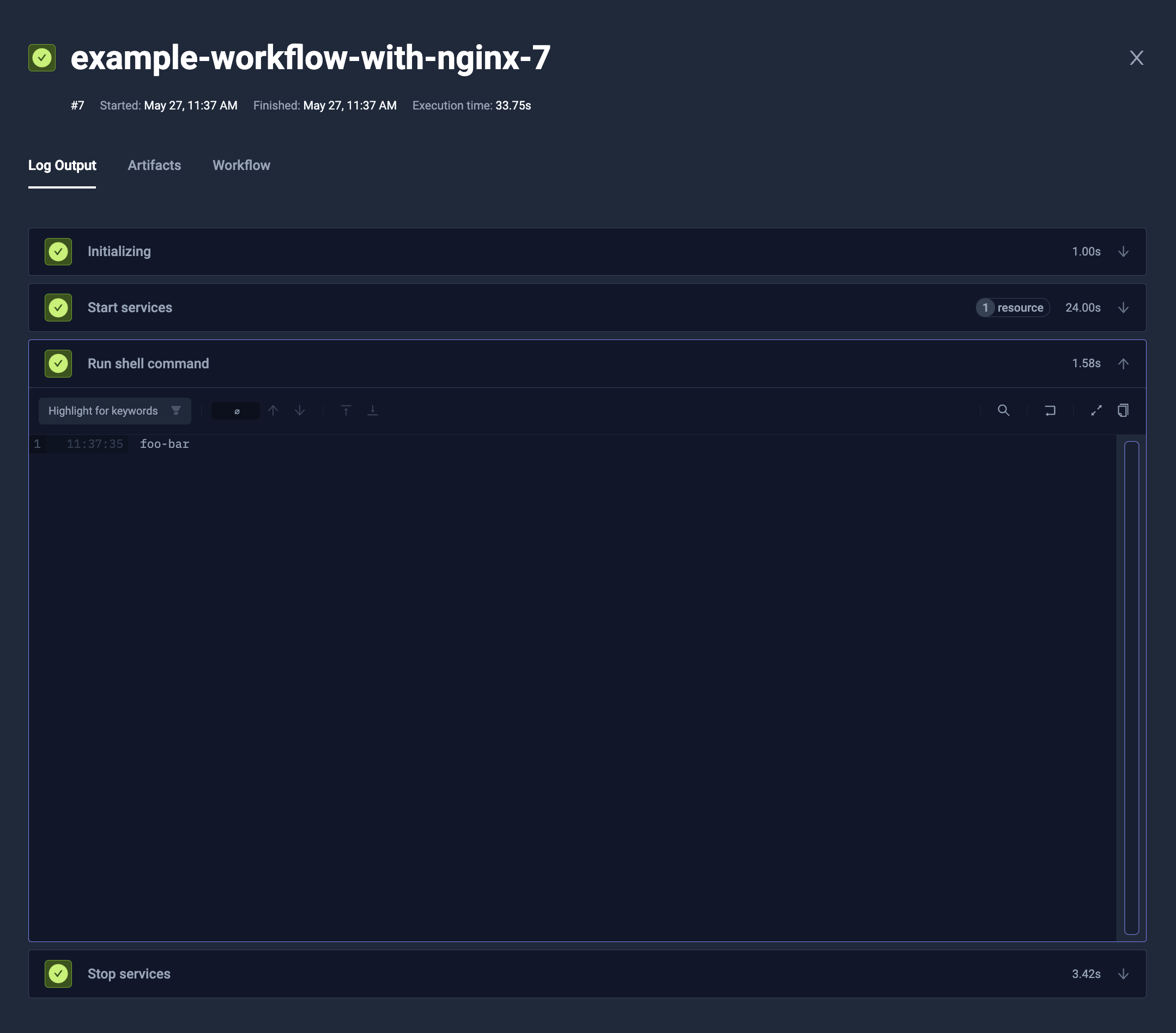
Examples
JMeter with distributed Remote Workers
You can easily run JMeter with distributed remote workers, that could be even spread evenly across all the Kubernetes nodes.
The example below:
- Read JMX configuration from Git repository (
spec.content.git) - Start 5 remote workers (
spec.services.slave.count)- Distribute them evenly across nodes (
spec.services.slave.use[0]-distribute/evenlytemplate is setting commonpod.topologySpreadConstraints) - Reserve 1/8 CPU and 128MB memory for each instance (
spec.services.slave.container.resources) - Wait until they will accept connection at port 1099 (
spec.services.slave.readinessProbe)
- Distribute them evenly across nodes (
- Run JMeter controller against all the remote workers (
spec.services.steps[0].run)- It uses
{{ services.slave.*.ip }}as an argument -services.slave.*.ipwill return list of IPs, and they will be joined by comma (,) to convert to text
- It uses
apiVersion: testworkflows.testkube.io/v1
kind: TestWorkflow
metadata:
name: distributed-jmeter-example
spec:
content:
git:
uri: https://github.com/kubeshop/testkube
revision: main
paths:
- test/jmeter/jmeter-executor-smoke.jmx
container:
workingDir: /data/repo/test/jmeter
services:
slave:
use:
- name: distribute/evenly
count: 5
timeout: 30s
image: alpine/jmeter:5.6
command:
- jmeter-server
- -Dserver.rmi.localport=60000
- -Dserver_port=1099
- -Jserver.rmi.ssl.disable=true
container:
resources:
requests:
cpu: 128m
memory: 128Mi
readinessProbe:
tcpSocket:
port: 1099
periodSeconds: 1
steps:
- name: Run tests
run:
image: alpine/jmeter:5.6
shell: |
jmeter -n \
-X -Jserver.rmi.ssl.disable=true -Jclient.rmi.localport=7000 \
-R {{ services.slave.*.ip }} \
-t jmeter-executor-smoke.jmx
Selenium tests with multiple remote browsers
You can initialize multiple remote browsers, and then run tests against them in parallel.
The example below:
- Clone the test code (
content) - Start 3 instances of
remoteservice (services.remote)- Each instance have different browser used (
imageofservices.remote.matrix.browserpassed toservices.remote.image) - Each instance expose the driver name in their description (
driverofservices.remote.matrix.browserpassed toservices.remote.description) - Wait until the browser is ready to connect (
services.remote.readinessProbe) - Always save the browser logs (
services.remote.logs)
- Each instance have different browser used (
- Run tests in parallel for each of the browser (
steps[0].parallel)- Run for each
remoteservice instance (steps[0].parallel.matrix.browser) - Transfer the code from the repository to the parallel step (
steps[0].parallel.transfer) - Sets the environment variables based on the service instance's description and IP (
steps[0].parallel.container.env) - Run tests (
steps[0].parallel.shell)
- Run for each
- YAML
- Log Output
kind: TestWorkflow
apiVersion: testworkflows.testkube.io/v1
metadata:
name: selenium-remote-browsers-example
spec:
content:
git:
uri: https://github.com/cerebro1/selenium-testkube.git
paths:
- selenium-java
services:
remote:
matrix:
browser:
- driver: chrome
image: selenium/standalone-chrome:4.21.0-20240517
- driver: edge
image: selenium/standalone-edge:4.21.0-20240517
- driver: firefox
image: selenium/standalone-firefox:4.21.0-20240517
logs: always
image: "{{ matrix.browser.image }}"
description: "{{ matrix.browser.driver }}"
readinessProbe:
httpGet:
path: /wd/hub/status
port: 4444
periodSeconds: 1
steps:
- name: Run cross-browser tests
parallel:
matrix:
browser: 'services.remote'
transfer:
- from: /data/repo/selenium-java
container:
workingDir: /data/repo/selenium-java
image: maven:3.9.6-eclipse-temurin-22-alpine
env:
- name: SELENIUM_BROWSER
value: '{{ matrix.browser.description }}'
- name: SELENIUM_HOST
value: '{{ matrix.browser.ip }}:4444'
shell: mvn test
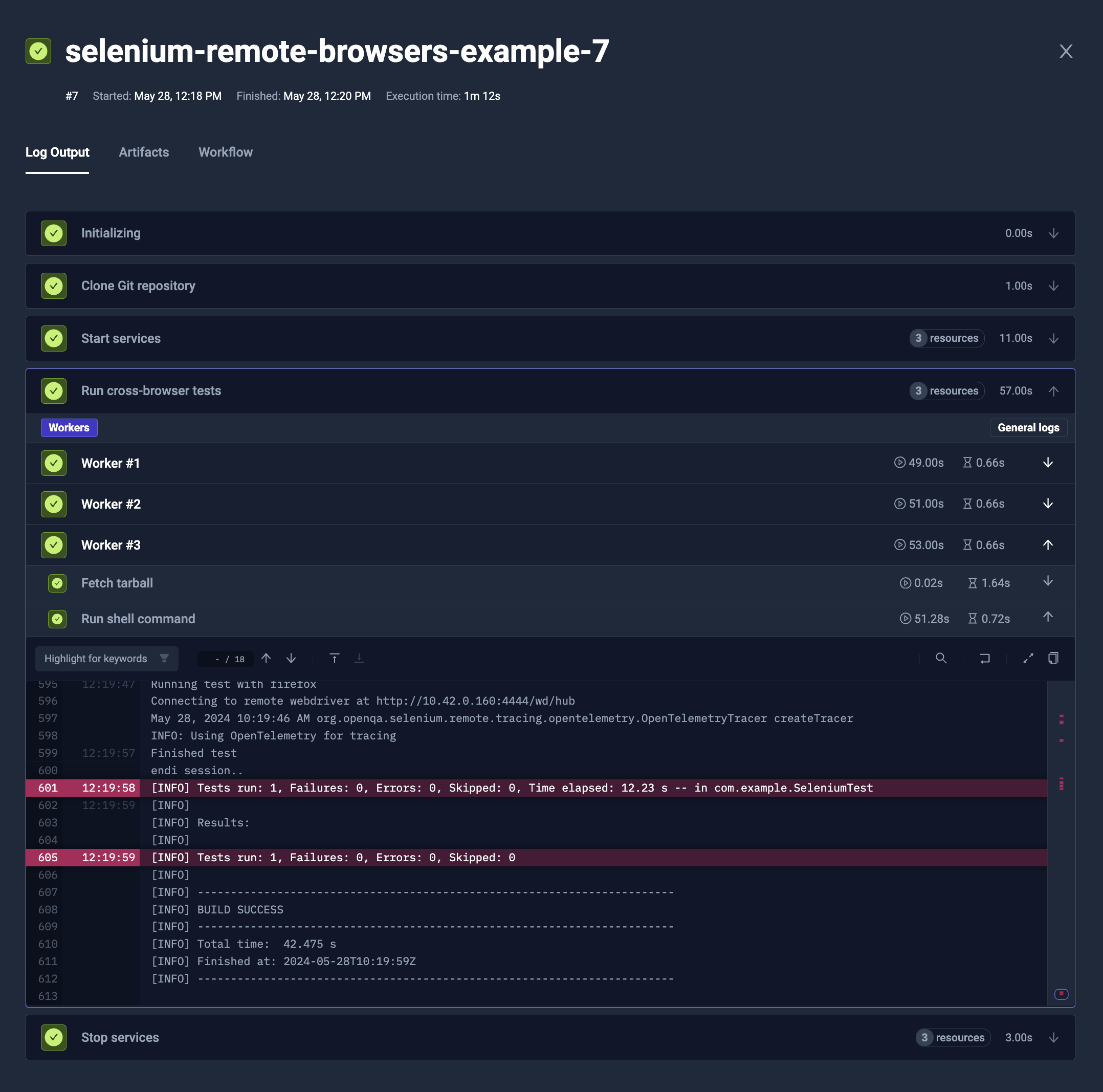
Run database for integration tests
To test the application, you often want to check if it works well with the external components too. As an example, unit tests won't cover if there is a syntax error in SQL query, or there are deadlocks in the process, unless you will run it against actual database.
The example below:
- Start single MongoDB instance as
dbservice (services.db)- Configure initial credentials to
root/p4ssw0rd(services.db.env) - Wait until the MongoDB accept connections (
services.db.readinessProbe)
- Configure initial credentials to
- Run integration tests (
steps[0].run)- Configure
API_MONGO_DSNenvironment variable to point to MongoDB (steps[0].run.env[0]) - Install local dependencies and run tests (
steps[0].run.shell)
- Configure
apiVersion: testworkflows.testkube.io/v1
kind: TestWorkflow
metadata:
name: database-service-example
spec:
content:
git:
uri: https://github.com/kubeshop/testkube.git
revision: develop
services:
db:
image: mongo:latest
env:
- name: MONGO_INITDB_ROOT_USERNAME
value: root
- name: MONGO_INITDB_ROOT_PASSWORD
value: p4ssw0rd
readinessProbe:
tcpSocket:
port: 27017
periodSeconds: 1
container:
workingDir: /data/repo
steps:
- name: Run integration tests
run:
image: golang:1.22.3-bookworm
env:
- name: API_MONGO_DSN
value: mongodb://root:p4ssw0rd@{{services.db.0.ip}}:27017
shell: |
apt-get update
apt-get install -y ca-certificates libssl3 git skopeo
go install gotest.tools/gotestsum@v1.9.0
INTEGRATION=y gotestsum --format short-verbose -- -count 1 -run _Integration -cover ./pkg/repository/...